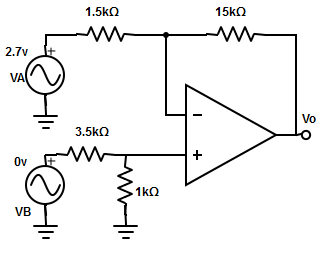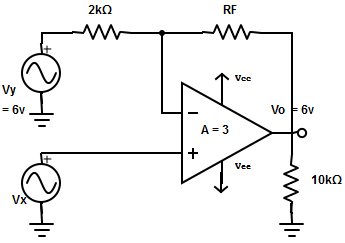This set of Linear Integrated Circuit Multiple Choice Questions & Answers (MCQs) focuses on “Differential Amplifiers with Multiple Op-Amp – 1”.
1. Why differential amplifiers are preferred for instrumentation and industrial applications?
a) Input resistance is low
b) Produce amplified output
c) Amplify individual input voltage
d) Reject common mode voltage
View Answer
Explanation: Differential amplifiers are preferred in these applications because they are better able to reject common-mode voltage than single input circuits and present balanced input impedance.
2. Which of the following is a combination of inverting and non-inverting amplifier?
a) Differential amplifier with one op-amp
b) Differential amplifier with two op-amps
c) Differential amplifier with three op-amps
d) Differential amplifier with four op-amps
View Answer
Explanation: In differential amplifier with one op-amp both the inputs are connected to separate voltage source. So, if any one of the source is reduced to zero, differential amplifier acts as an inverting or non-inverting amplifier.
3. What will be the output voltage when Vx =0v?
(Where Vx –> inverting input terminal of differential amplifier with one op-amp)
a) Vo = -(1+R F/R1)*V1
b) Vo = -(1- R F/ R1)*V1
c) Vo = (1+ R F/ R1)*V1
d) Vo = (R F/ R1)*V1
View Answer
Explanation: When Vx =0v, the configuration is a non-inverting amplifier.
4. Compute the output voltage from the following circuit diagram?

a) -17v
b) -27v
c) -39v
d) -15v
View Answer
Explanation: Since VB=0, the configuration becomes as an inverting amplifier. Hence, the output due to VA is
Vo = -(RF/R1)*VA = -(15kΩ/1.5kΩ)*2.7v = -10*2.7 = -27v.
5. Compute the output voltage if the input voltage is reduced to zero in differential amplifier with one op-amp?
a) Inverted Voltage
b) Same as the input voltage
c) Amplified inverted voltage
d) Cannot be determined
View Answer
Explanation: It is not mentioned clearly whether inverting input or non-inverting input is reduced to zero. Therefore, the output cannot be determined.
6. The difference between the input and output voltage are -1v and 17v. Calculate the closed loop voltage gain of differential amplifier with one op-amp?
a) -51
b) 34
c) -17
d) 14
View Answer
Explanation: Voltage gain of differential amplifier with one op-amp, AD=Output voltage / Difference of input voltage
=> AD = 17v/-1v = -17v.
7. For the differential amplifier given below, determine the Vx and RF value. Assume that the circuit is initially nulled.

a) Vx = -8v, RF = 9.9kΩ
b) Vx = 8v, RF = 9.9kΩ
c) Vx = -8v, RF = -9.9kΩ
d) Vx = 8v, RF = -9.9kΩ
View Answer
Explanation: The closed loop voltage gain, AD = -(RF/R1)
=> RF = -3*3.3kΩ = -9.9kΩ
The net output is given is VO=-(RF /R1)*(Vx-Vy)
=> Vx= Vy– Vo (-R1 /RF)
=> Vx = 6+6(3.3kΩ/9.9kΩ) = 6+2 = 8v.
8. The gain of differential amplifier with one op-amp is same as that of
a) The inverting amplifier
b) The non-inverting amplifier
c) Both inverting and non-inverting amplifier
d) None of the mentioned
View Answer
Explanation: The gain of differential amplifier is given as AD= -(RF /R1), which is equivalent to the output voltage obtained from the inverting amplifier.
9. Find the value of input resistance for differential amplifier with one op-amp. If R1 = R2=100Ω and RF = R3 =5kΩ.
a) RIFx = 110Ω; RIFy = 6.7kΩ
b) RIFx = 100Ω; RIFy = 5.1kΩ
c) RIFx = 150Ω; RIFy = 7.2kΩ
d) RIFx = 190Ω; RIFy = 9.0kΩ
View Answer
Explanation: The input resistance of inverting amplifier is RIFx = (R1) and the input resistance of non-inverting amplifier is RIFy = (R2+ R3)
=> ∴ RIFx = 100Ω and
=> RIFy =100+5kΩ =5.1kΩ.
10. What is the net output voltage for differential amplifier with one op-amp
a) Vo = -(RF /R1)*Vx
b) Vo = -(RF /R1)*(Vx -Vy)
c) Vo = (1+RF /R1)*(Vx -Vy)
d) None of the mentioned
View Answer
Explanation: The net output voltage for differential amplifier with one op-amp is given as Vo= -(RF /R1)*(Vx-Vy).
Sanfoundry Global Education & Learning Series – Linear Integrated Circuits.
To practice all areas of Linear Integrated Circuits, here is complete set of 1000+ Multiple Choice Questions and Answers.
If you find a mistake in question / option / answer, kindly take a screenshot and email to [email protected]
